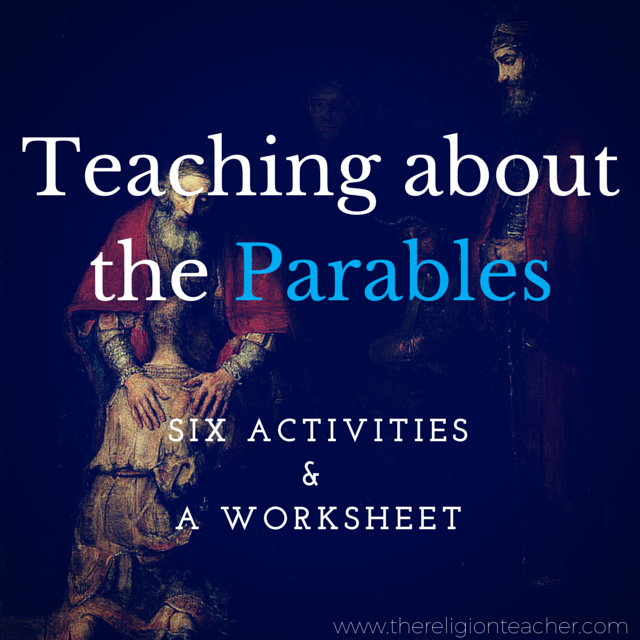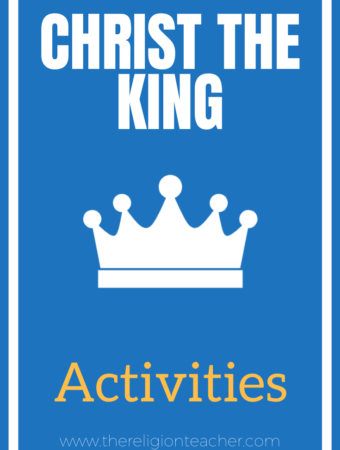“The disciples approached him and said, ‘Why do you speak to [the crowds] in parables?’ He said to them in reply, ‘Because knowledge of the mysteries of the kingdom of heaven has been granted to you, but to them it has not been granted.'”
Matthew 13:10-11

New! The Religion Teacher’s Parable Worksheet Pack includes thirty-four printable handouts to help your students read, understand, and pray with the Jesus’ parables.
When Jesus spoke to the crowds (the group of people who had not yet decided to become his disciples), he shared stories to express symbolically who and what God and his kingdom are like.
Most of the time, people didn’t completely understand what he was trying to say. This is because the parables that Jesus shared always shocked them. These simple, shocking stories stuck with people. They were hard to forget. They almost always shattered some kind of misconception about the world, God, and how we should act toward one another.
(Related resource: Why did Jesus speak in parables?)
As young people, most of us learned these parables growing up. We know the stories before we even read them. Unfortunately, this means that we often forget about the shock-value of the stories. We miss the deeply surprising details and take the story for granted.
That’s the last thing we want to do as catechists and teachers introducing the parables to a new generation of young people.
When we present the parables, we want to make sure that they listen and respond with questions and curiosity. We want these stories to be surprising. We want our students to continue to wrestle with them mentally so that they can also wrestle with the way they integrate them into their daily lives.
Listening or reading the parables should ultimately challenge us to change the way we live. They should lead to conversion and the decision to leave everything in pursuit of God’s kingdom.
Teaching about the Parables
Here are a few ways to effectively teach about the parables to young people today:
1. Read the parable slowly with explanations, questions, and repetition.
Help your students understand the historical context and meaning of everything in the story. You may have to explain who the Pharisees or Samaritans were in some of the parables. You will need to stop and explain what Jesus meant when he referred to seeds being sown on rocky ground. Depending on where you live, your students may have very little understanding of farming, shepherding, or working in a vineyard.
2. Show pictures and images of classical art.
Find some photos or classical renditions of the parables and show it to the students for context. Read the story, then identify in the paintings how the artist portrayed the story in creative ways.
I have spent multiple days analyzing and reflecting on Rembrandt’s classic rendition of The Return of the Prodigal Son with students. They rarely get that opportunity to reflect on paintings and it appeals to the visual learners in class.
3. Act out the Parable
Assign roles and have groups plan and perform a skit of one of the parables. Some might be easier to act out than others. Make sure you pick a few parables of equal length so that all of the groups finish in about the same amount of time.
Here are a few parable skits you might try:
4. Chart the Symbolism
Create a chart on the board or create flash cards that show the symbolism in the story. Who does the shepherd represent? And the sheep? What is the seed in this story? How about the father? And the sons? And the wedding party guests?
Each of the parables offers slightly different representations of people of Jesus’ day. Make sure you also make connections with the type of people that each story might represent today as well.
Note: Download the worksheet below for a simple parable chart.
5. Modernize the Parable
Have students re-write the parable in modern day symbolism. Instead of farmers and shepherd, for example, use computer programmers and CEOs of companies. Instead of workers in a vineyard, use skyscraper construction workers. Instead of seeds or fields, write stories with sporting equipment and stadiums. Let the students be creative but make sure the moral of the story is always the same.
6. Lead them in a Meditation
Ask the students a series of questions that gets them to relate the story to their life. For example:
- How are you like the . . . in the story?
- Have you ever . . . like this story?
- Is anyone like the . . . in the story?
- Who are they . . . in the story today?
- If you were the . . . in the story, how would you react?
Download a Parable Worksheet
If you are looking for something simple to use in class, download this worksheet with a set of four questions to help guide students through a process of Lectio Divina using the parables. By answering the questions, students will be guided through each step of Lectio Divina: lectio, meditatio, oratio, and contemplatio.
Or, if you would like a worksheet specifically designed for each one of Jesus’ most popular parables, check out The Religion Teacher’s Parable Worksheet Pack.



Enjoying your “31 days” book.
The Parables info ….don’t know how much time there is to use the Bible with the text our church uses. But the info is good for Bible studies with our Adult Faith groups.
I’ll pass along your website when we have our teachers meeting soon.
from a Grandmother going back to teaching. Thanks
Thank you for all the information. Of big help.